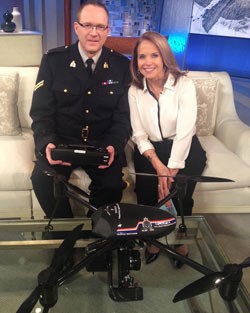Finding a missing person is a matter of using every tool at your disposal, and one of those tools is an Unmanned Aerial Vehicle. Recently the Saskatoon Rural RCMP made use of such a device to locate a missing man near St. Denis.
Cpl. Doug Green who now resides in Saskatoon but is a former Yorkton resident, explains that in May of 2013 a man rolled his truck just after midnight on Highway 5, four miles east of St. Denis. Upon arrival, RCMP found the vehicle rolled in the north ditch, but didn't find any occupants. A ground search was conducted, and STARS Air Ambulance was called to do an aerial search, as well as Green with the UAV and the Forward Looking Infrared (FLIR) camera. With the help of a GPS coordinate pulled from the missing man's phone, located about two miles south of the rollover scene, Green says they were able to get a general search area, and found a heat signature that could have potentially been the person they were searching for. At this point the UAV became low on batteries, but with the location, the ground team was able to find the missing man and get him to the ambulance.
The key to this successful search was the FLIR, which shows heat signatures as white on the image. With that camera, it was able to find a warm body at night, something that was vital to get to the man in time.
"It would have taken us hours with a dog to even determine his track and find him. When we did find him, he was so cold that he was to the point where he was not shivering anymore, so that put him into the later stages of hypothermia."
Green emphasizes that a successful search relies on every single tool at a rescuers disposal, and the UAV made a difference in this case because they had a recent location to begin the search.
"We can't cover large tracks of land with them, we had a recent location to go to. Trying to search 10 miles, it's impossible with these... It may not work in every situation, but if we can get this technology to a scene, our chances of success are greater."
There are limitations to the device, explains Green, the main one being battery life. The vehicle itself gets around twenty minutes of air time before the batteries need to get switched out, and there are limits to the distance that can be flown.
There are six UAVs in the province, including one in Yorkton, sourced from a company in Swift Current. They have been in use since 2010, but the primary use of the UAV is in collision and crime scene reconstruction, Green explains.
"We can deploy these straight up over the scene, we can't go over 500 ft. of course, but we can get very good, steady aerial photos of evidence and a scene with these."
"We realized that with the FLIR we can use these for emergency response-type calls where we are providing over watch from above for both officer and public safety."
Green emphasizes that the use of the UAV will be restricted to collision reconstruction, documenting crime scenes, emergency response and search and rescue. He notes that they are restricted by Transport Canada guidelines for safety reasons as well as privacy regulations and RCMP policy. For example, the operator of the UAV must always be in the line of sight of the device.
"We won't be using these unless we have some sort of police action in place at a location."
This rescue has garnered international attention, and Green says he didn't expect the level of interest that it received, but in hindsight the event was the first of its kind.
"As far as we know, this is the first successful search and rescue with a UAV in the world."




